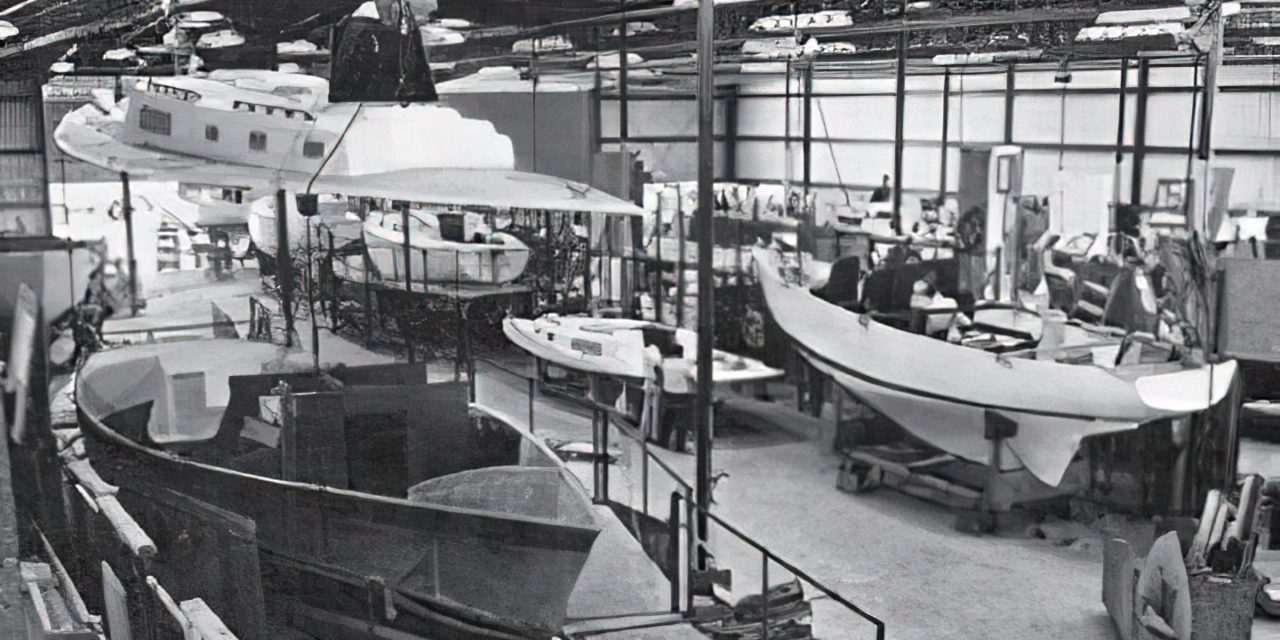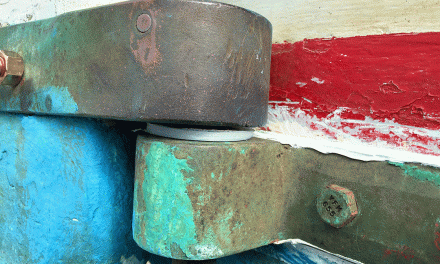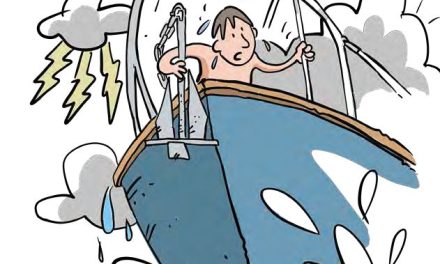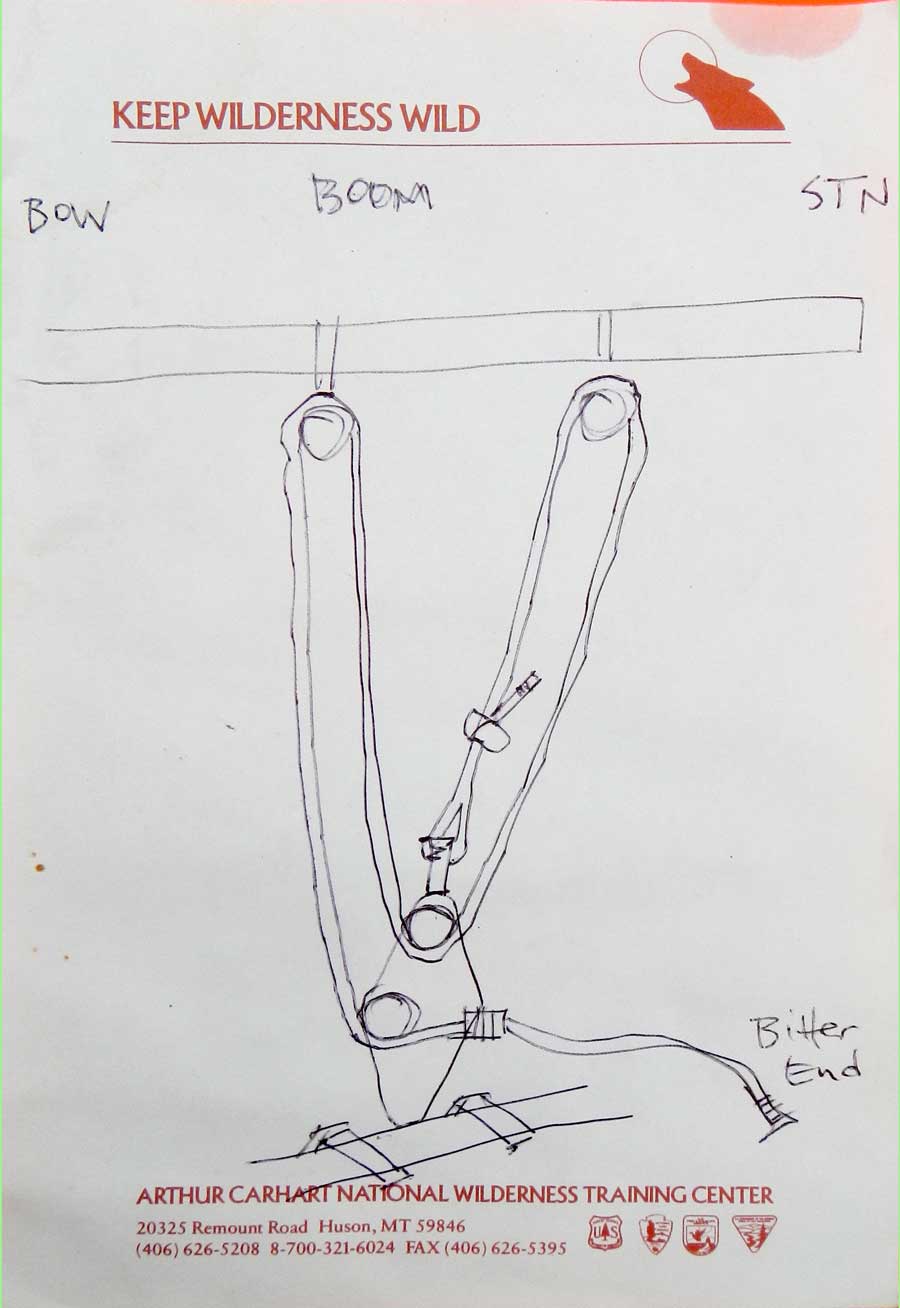Charley Morgan — 1929-2023
Sailing legend Charles E. Morgan (Charley to his friends, which was just about everyone) passed away January 6, 2023 on Treasure Island, Florida, at the age of 93, mere hours after the passing of his wife Maurine.
The following Good Old Boat article that I wrote in 2005 tells the high-points of Charley’s illustrious career but, he deserves emphasis for a few of the most notable:
- Longtime designer, builder of custom and production sailboats, and sailmaker.
- Probably the only person in the long and storied history of the America’s Cup to design, finance, build, skipper, and make the sails for a Cup boat — Heritage.
- Winner of two SORC (Southern Ocean Racing Conference) events in boats he designed, built, and skippered (1961 and 1962).
- Revolutionized the Caribbean charter trade with the Morgan Out Island 41, of which more than 1,000 were built.
And a genuinely good guy. RIP, Charley.
– Dan Spurr
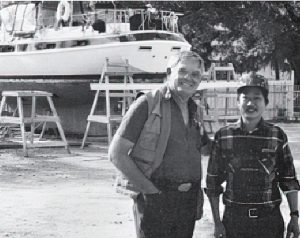
Charley Morgan, left, with Paul Benfield, owner of the Tibbets Boatyard. Behind them is a Morgan Out Island 51.
He found the best way to win was to build his own boats
Florida, like California, with its eternally warm weather and friendly skies, is a natural place in which to build boats — and was especially so back in the early days of fiberglass when hulls were cured outdoors using sunlight as the catalyst. A cheap labor pool also was available. Boatbuilders sprang up on both Florida coasts — in Miami and in the Tampa-St. Petersburg area. Many are still there, not on the water where real estate is too expensive but — as in Costa Mesa, California, the Mecca of 1960s fiberglass boatbuilding in this country — inland, back in the dusty, nondescript industrial zones next-door to plumbing and building supplies.
Charles Morgan, born November 17, 1929, in Chicago, now a yacht designer and consultant, hasn’t built a sailboat in many years, but during the late 1960s and through the 1970s he was a formidable force in the exploding fiberglass sailboat industry. He was the designer of Heritage, a 1970 America’s Cup 12-Meter; the designer and builder of Paper Tiger, winner of the prestigious Southern Ocean Racing Circuit (SORC); a production boatbuilder of Morgan Yachts; and an independent designer and consultant. He’s done it all.
Aeronautical engineer
Charley Morgan grew up on the west coast of Florida messing about in boats and went to college close to home, first to Valencia Junior College in Orlando and then to the University of Tampa, where he planned on being an aeronautical engineer. Following graduation he worked a short time for a telephone company before getting sidetracked by sailing.
“I went queer for boats,” he says, explaining why he took a job at Johnson Sails in Tampa and then opened his own loft, Morgan Racing Sails, in 1952 in St. Petersburg.
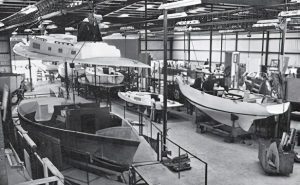
At Morgan Yachts’ St. Petersburg, Florida, facility, men worked from scaffolding on boats of all sizes. Note how the decks were moved and positioned from overhead beams.
A colorful, bright, energetic bear of a man, he next taught himself yacht design. His first design and build was called Brisote, which is Cuban for squall or fresh breeze. She measured 31 feet 6 inches, had a 22-foot waterline, an 8-foot 6-inch beam, a 5-foot draft, displaced 4,500 pounds, and carried 283 square feet of sail. Charley Morgan and his friend, Charlie Hunt, designed and built her out of plywood with a steel backbone. Initially, she had a Star Boat keel and rudder, a Thistle mainsail, and a modified Penguin sail for a mizzen. Later, Charlie Hunt built a bolt-on fiberglass keel for trailering. Together they entered Brisote in the 1957 St. Petersburg-Havana race, but the committee rejected her because she had no engine. Charley protested what he thought was a ridiculous rule and won a reversal. The two went on to take second in class. This success inspired what is probably Charley Morgan’s most famous design, the 40-foot Paper Tiger, which has a yawl rig like Brisote. Charlie Hunt had just shown him an early one-off fiberglass boat called Rare Aves, a fixture at the Coral Reef Yacht Club in Miami. After seeing it, Charley decided to give Paper Tiger a fiberglass hull too.
Rust, shatter, and rot
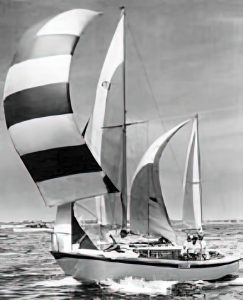
Charley Morgan’s first boat, Brisote. Demonstrating considerable resourcefulness, she had a Star Boat keel and rudder, a Thistle mainsail, and a modi- fied Penguin sail for a mizzen.
Charley built the hull and deck himself, with help from a young aerospace engineer named John Mills. Charley recalls stopping by the local yacht club one day after finishing work at the shop. “The old savants were sitting in the club, and I came in with resin all over me. One of the guys said, ‘I under- stand it’s got a steel backbone, wooden decks, and a fiberglass hull; you know, it’s gonna rust, shatter, and rot.’ ”
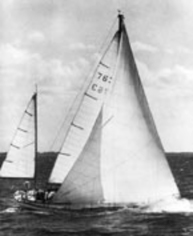
Paper Tiger was perhaps Charley’s most famous design. She won the SORC for two consecutive years, in 1961 and 1962.
Clark Mills, designer of the International Optimist Pram and the Windmill, finished Paper Tiger for Jack Powell, for whom Charley had designed her. But at first Clark was skeptical. When Charley showed him the boat, Clark hooked his thumbs in his pockets, chewed on his stogie, cocked his head, and said, “Well darn- it, I’ve built boats from scratch, kits . . . you name it. But this is the first time someone’s brought me a coat of paint and asked me to build a boat inside it.”
History will not forget what that “coat of paint” accomplished. In an unprecedented feat, Paper Tiger twice took overall SORC honors in 1961 and 1962.
Charley next designed the 28-foot Tiger Cub and began looking for a builder. The search proved futile, so he did the only logical thing he could — he formed Morgan Yachts and built them himself. They were all essentially one-offs, that is, they were not built from the same reusable mold.
The Tiger Cub later became the Columbia 31, but that didn’t happen until after Dick Valdes and Vince Lazzara put Charley’s 40- foot Sabre into production as the Columbia 40, a generous move by Vince which was intended to help Charley launch his own business.
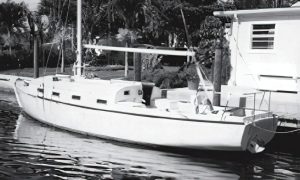
The one-off Rare Aves, the first fiberglass boat Charley ever saw, inspired him to build Paper Tiger out of the same new material. Rare Aves still sails today from her home port in the Florida Keys.
Lost the Circuit
The speedy centerboarder had nearly won the 1964 SORC and looked to be a good bet for the general market. “We won the Nassau Race and the Lauderdale Race,” Charley lamented years later, “and still lost the Circuit, if that’s possible.”
Also that year he built what he says was then the world’s largest fiberglass sailboat, the 60-foot Maredea, whose hull form was tank tested. The result: first place in the St. Petersburg-to-Venice, Florida, race.
In 1965 business was so good the company temporarily stopped taking orders. They were building a wide range of boats, from the $995 Wind- mill to a $44,900 45-footer. Gross that year was $1.7 million. Unlike a lot of builders, Charley handled finances well, once remarking, “Nothing leaves that driveway out there unless and until it’s paid for.”
Charley’s childhood friend, Bruce Bidwell, joined him that year and together they introduced the Morgan 34, which the ads described as “an immediately successful racer/cruiser and an attractive, beamy, keel-centerboarder, CCA-style yacht . . . for families for whom yachting is a way of life.”
The Cruising Club of America (CCA) rule attempted to encourage designs that would be safe, comfortable family cruisers as well as decent performers on the racecourse. Notable features included short waterlines (the long overhangs would immerse when heeled to increase sailing length beyond the measured length), large mainsails and small foretriangles (partly because big multispeed winches hadn’t been developed yet). These boats were often yawls because the mizzen staysail was essentially unpenalized by the rating rule. A lot of them were centerboarders because shoal draft was important in Charley’s native waters of south Florida.
Smaller wetted surface
In the Morgan 24, the rudder was separated from the keel-centerboard — a major step forward in yacht design. Charley wasn’t the first to do this, but the Morgan 24’s racing record helped to validate the idea. Not only did the emergence of the fin keel help the boat turn more quickly in prestart maneuvers, it also greatly reduced wetted surface area, which meant less friction and, therefore, faster speeds.
The Morgan 24 is still a good performer by today’s standards, with moderate displacement and shoal draft. And — priced around $5,000 — it’s a terrific value for anyone looking for a boat in this size range.
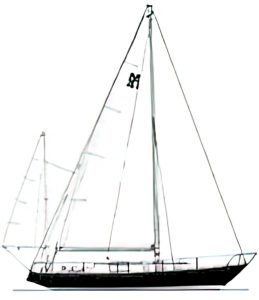
Morgan 41 Illustration
Other boats to follow included the Morgan 30, 41, and 45, which later was built as the Starrett & Jenks 45. But it was the development of the Out Island series — 28, 33, 36, 41, and 51 — that gave the company a big burst of business.
Charley’s interest in racing never waned, though, and he continued to de- sign and build custom boats. One was Rage, which he, with Halsey Herreshoff as navigator, took to second place in the 1968 Newport-to-Bermuda race.
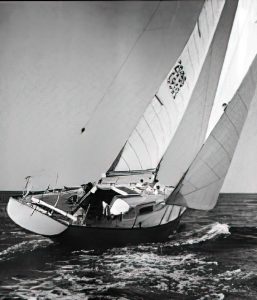
Morgan 41
The Out Island series
“The Morgan Out Island 41,” Charley says, “was the extension of a long study period, where we tried to create a commodious and comfortable tri-cabin arrangement. In 1970 we finally got it worked out — human engineering and ergonomics. We designed and aimed it at cruisers as well as the charter-boat market. We sought input from a lot of companies big and small, including the Moorings and Jack Van Ost [a dentist who became a successful builder of CSY boats for his charter business].
“The boat was designed to compete with the boats being put out by Gulfstar, which were for a new market that Vince Lazzara [who by now had left Columbia in California and started Gulfstar in Florida] had perceived. Our dealers had requested for a long time a boat without a centerboard that was shoal with lots of room; it didn’t need to sail like a rocket. It came out at the Annapolis Boat Show and was an instant sellout. We built, in the first calendar year, over $4 million worth — 120 units. Eventually we built those boats on two lines, with them coming off the combined lines one a day. They number in excess of 1,000.”
In all, Morgan Yachts built more than 40 different production models, beginning with Charley’s trademark centerboarders, the Out Islands, the Henry Scheel-designed 45/46 (originally built by another builder as the Scheel 45), and a number of boats designed to the International Offshore Rule (IOR), including the Morgan 33 ¾-Ton and Morgan 36 One-Ton. Sailing Kit Craft made a number of designs avail- able in kit form because, as Charley says, “there were so many people who wanted to get a hold of one of our boats who couldn’t afford a finished boat.” But along with a handful of other 1970s builders, such as Islander and Columbia, Morgan Yachts dropped the practice because many owner-completed boats were poorly finished, reflecting adversely on the manufacturer.
Retirement day
Charley remembers well the day he retired. It was June 6, 1972, he recalls with certainty. It was easy to see that divorcing himself from the company he’d created was a watershed in his career . . . and life. He’d merged the company into Beatrice Foods four years earlier (1968) and had stayed on as chairman of Morgan Yacht Corporation. But for Charley, like many people, working for a large corporation was difficult after he had been in business for himself.
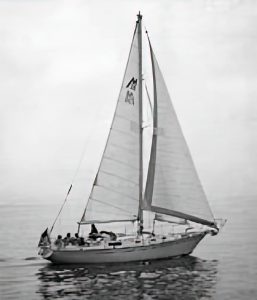
Morgan 38
Later, Beatrice Foods sold Morgan Yachts to Thor Industries. Subsequently, in 1984 it was passed along to Frank Butler and Catalina Yachts, which continued to build the Morgan 38 and the Out Island 41 (Classic 41) for a number of years before finally putting them to bed.
Of Morgan Yachts’ many accomplishments, one that makes Charley positively beam is the boats he built for Disney World long before it got into the cruise business. “There was a time we built the largest fiberglass boats in the world,” he said. “Morgan Yachts designed and built the principal original watercraft for Disney World, a whole fleet of them, the largest of which is around 120 feet — sub- marines, the jungle cruise boats, the steam launches. In all, more than a hundred. It’s exciting the way you can completely create out of glass some- thing that looks like wood; on the submarines we faked the scales and rivets. We created an incredible theatrical appearance for Disney.”
Charley also designed motor yachts such as the West Indian 36, a hover- craft, and Heritage, the last wooden American 12-Meter (France II was the last in wood among all nations). Alas, Heritage lost to Intrepid in the 1970 defender trials.
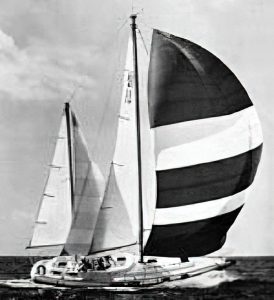
Between 1971 and 1984 more than 1,000 Morgan Out Island 41s were built. Later, after Catalina Yachts acquired some Morgan molds, the 41 was resurrected with minor modifications and sold as the Morgan Classic 41.
Way of measuring
Cindy Goebels, reporting in Southwinds magazine, said Charley ex- plained his interest in the America’s Cup thus: “It’s all just another way of measuring yourself. Competitive men always want to know how big they are in relation to others, how they can perform. Dollars are a way of keeping score. There may be other means in a more mature society. Why this? Well, there’s damn little you can justify out- side of wanting to keep on breathing.” Charley Morgan was always a good interview, seldom mincing words.
Morgan Yachts’ St. Petersburg facilities were considered modern and first-class. “We maintained a laboratory and did a lot of outside testing,” Charley says. “We were using balsa cores from the beginning. Later I was a great proponent of Airex. Then came Divinycell, Klegecell, carbon fibers, Kevlar, and the utilization of high- modulus materials. Way back in 1965 and 1966 we were researching work done in the aircraft and aerospace industry. But those materials had no place in yacht building in those days because lightness was not the key- note; the economic issues were more important . . . and the ability to have readily available resources.”
Charley likes to talk about how the advent of fiberglass changed the face of American boating. “You didn’t have to be an extremely wealthy person to think about owning a boat,” he says. “The concept of the non-wasting asset. You could treat ’em and deal ’em like automobiles. You had an orderly market and the burgeoning charter boat and used-boat market. It just altered completely the brokerage firms. Back in the days after the end of World War II, you could count on your fingers the brokerage firms: S&S, Northrop & Johnson. Bang, bang, in one fell swoop, the tides changed and ripped over us.
Dramatic change
“The thing that kept coming through to me was the dramatic change that was made by fiberglass and the huge opportunity given to the American boater.
“Look at the Ensenada Race – all the ones going down to Mexico – huge clusters of boats! In the Great Lakes, the Mackinac Race had a few entries before the war, but bang! At the end of the war they started getting some fiberglass boats on the scene – my word! — you’re looking at 100-boat fleets or better. It made a major change for Americans who wanted to become part of sailing and yachting. Our ad used to say, ‘The past decade’s most exciting new construction medium.’ How prophetic those words were.
“What sort of disturbs me these days is when they tag the sailing boat people as elitist. I like to say that they’re really more dedicated and enthusiastic about their sport and therefore have organized it more so it has the appearance of elitism.
“The only boats I’ve seen break up are some racing boats that were really lightly built, crossing the Stream or something. I’ve traced a few of those stories about boats splitting in two – bull! I’m sure there are some examples, but the truth is that fiberglass is marvelous.”
And of the strength and longevity of fiberglass?
“I hate to tell you how quickly a wooden boat goes down. We crossed the finish line down in Sarasota after getting chewed up in a nor’wester at the crack of dawn. We could see the committee boat in the murk, saw her lights and the farewell marker at Sarasota Pass. We went zooming by, struck the chute and mizzen staysail, jibed over, cranked up the engine, cleaned up the forward deck and started banging through the slop up toward the pass. Dawn had come. I looked up and yelled, ‘Hey, look! There’s some spreaders sticking up out of the water.’ The committee boat broke its line, blew up on the bar, popped like a cantaloupe, and went straight to the bot- tom. Pieces floating; heads bobbing around and lifejackets. She went down that fast. You kidding me?
“Yet I saw a whole night when [the fiberglass sailboat] Inferno sat over on the bricks at Lucaya [Grand Bahama] banging and slamming and scream- ing and moaning on those bricks. My heart was going out to that boat . . . the sea bursting over her. Three days later I saw her hauled out at Spencer’s in Palm Beach, and I went over and got up inside the boat, looked at the keel – gnawed up a little bit. Not bad!”
Another company
Guys like Charley Morgan are never really retired, even though they sometimes think they are. In 1975 he started yet another boatbuilding company, the Heritage Yacht Corporation. Perhaps anticipating the trend toward power, this time he built both fiberglass sailboats and trawler motoryachts. That venture wasn’t as financially successful, however, and he was forced to seek protection from creditors under Chapter 11 of the federal bankruptcy code. Subsequently, in the early ’80s he served for a short time on staff at Chris-Craft, while the remaining assets of Heritage went to Catalina, which had also bought Morgan Yachts from Thor Industries.
Today, Charley keeps a design studio in his home. Recent projects include two long-range motoryachts, one steel, the other aluminum, by Top- per Hermanson. But, he says, new de- sign commissions have fallen off considerably since 9/11. He says, “I’d love to do a full-powered steel auxiliary for the right person. Totally self-sufficient with watermakers, air-conditioning, whatever they want.” Like a lot of other people in the industry, he sees his aging followers taking an interest in the comforts of motoryachts, but not all want to go to sea without some sort of stick overhead.
To fill his time, Charley is teaching himself painting, taking after, in a reverse sort of way, his son and daughter, who are both artists.
And, of course, he still finds time for sailing. He was active in the local Star fleet until his wife became ill six years ago; he nursed her until her death in February 2001.
But, he says, he’ll do his yacht club’s Mexico race this year, and there’s always the Morgan Invasion, a rendezvous for owners, in which he participates.
Last October, the 19th annual Invasion was held at the Treasure Island Tennis and Yacht Club in Treasure Island, Florida. The event coincided with Charley’s 75th birthday. More than 100 boats participated. Nothing makes a designer or builder happier than seeing his boats still going strong and his owners happy. One of his favorites, Paper Tiger, recently resurfaced in the West Indies,” he says with pride. “And she’s till honkin’.”
So, too, one might add, is Charley Morgan.
Note: This article is a revised version of information included in Heart of Glass: Fiberglass Boats and the Men Who Made Them, by Dan Spurr.

